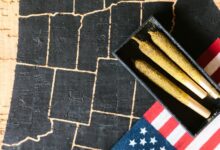When Did Cbd Become Legal

The legal status of CBD in the United States underwent significant changes with the passage of the 2018 Farm Bill. This legislation effectively removed hemp-derived CBD from the Controlled Substances Act, paving the way for its cultivation and distribution. However, the aftermath has led to a patchwork of regulations at the state level, complicating the landscape of CBD legality. Understanding these developments is crucial for grasping the current state of CBD products across the nation.
The Origins of CBD and Cannabis Legislation
As the conversation surrounding cannabis and its derivatives has evolved, understanding the origins of CBD and the legislative framework surrounding it is essential.
Hemp history reveals its longstanding use, yet cannabis prohibition stifled its potential for decades.
This complex interplay between societal perceptions and legal restrictions has shaped the current landscape of CBD, highlighting the necessity for informed discussions about its benefits and regulatory future.
The Impact of the 2014 Farm Bill
The passage of the 2014 Farm Bill marked a pivotal moment in the legal landscape of hemp and CBD in the United States.
By allowing states to cultivate hemp, the bill catalyzed significant CBD industry growth.
This legislation enabled farmers to explore hemp cultivation, fostering innovation and entrepreneurship, while paving the way for a burgeoning market centered around hemp-derived products and their potential benefits.
The 2018 Farm Bill: A Turning Point for CBD Legality
In 2018, a significant legislative change occurred with the passage of the Farm Bill, which effectively legalized hemp-derived CBD products on a federal level.
This pivotal legislation reshaped CBD regulations, allowing for broader cultivation and distribution.
The federal implications of this shift provided a foundation for industry growth, offering consumers increased access to CBD, while also prompting discussions about state-specific regulations and compliance.
Navigating State Regulations and Current Legal Status
Following the 2018 Farm Bill, the legal landscape for CBD products became more complex as individual states began to establish their own regulations.
These state variations introduced significant legal complexities, creating a patchwork of laws that can confuse consumers and businesses alike.
Navigating this evolving framework requires vigilance, as compliance with local legislation is essential for those seeking the benefits of CBD.
Conclusion
In conclusion, the journey to CBD's legal status has been akin to a winding river, shaped by significant legislative milestones and state-specific regulations. The 2018 Farm Bill marked a pivotal moment, allowing hemp-derived CBD to flow freely across the nation, yet the varied state laws create a patchwork of legality that continues to evolve. As consumers and businesses navigate this complex landscape, understanding local regulations remains essential for harnessing the full potential of CBD in today's market.






